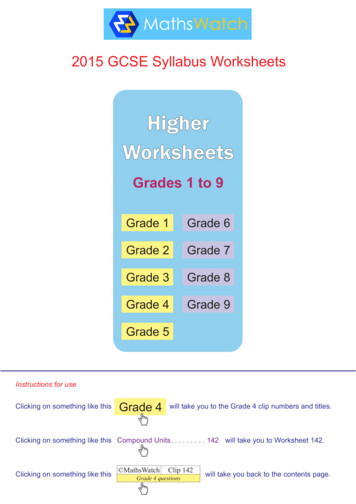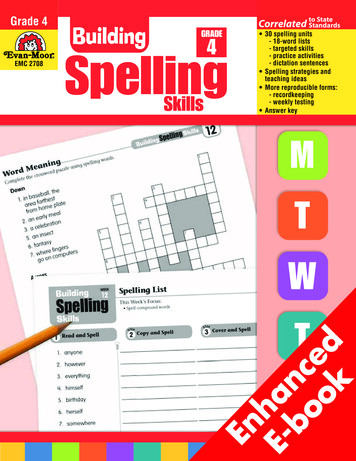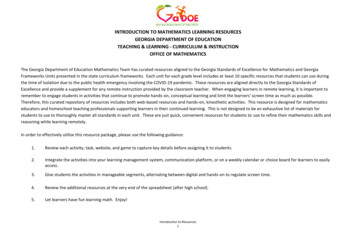
Transcription
K to Grade 2 Human Body SeriesThe Five SensesKidsHealth.org/classroomTeacher’s GuideYou use them every day to get to know and understand the world around you. Whatare they? Your senses! The five senses — seeing, hearing, smelling, tasting, andtouching — help us to learn about our surroundings. The following activities will helpyour students explore their senses.This guide includes: Standards Related Links Discussion Questions Activities for Students Reproducible MaterialsRelated KidsHealth LinksArticles for Kids:Your EyesKidsHealth.org/kid/htbw/eyes.htmlYour EarsStandardsThis guide correlates withthe following National HealthEducation Standards:Students will: Comprehend concepts relatedto health promotion anddisease prevention to enhancehealth. Demonstrate the ability toaccess valid information andproducts and services toenhance health. Demonstrate the ability to useinterpersonal communicationskills to enhance health andavoid or reduce health risks.KidsHealth.org/kid/htbw/ears.htmlYour NoseKidsHealth.org/kid/htbw/nose.htmlYour TongueKidsHealth.org/kid/htbw/tongue.htmlYour SkinKidsHealth.org/kid/htbw/skin.htmlAll About Your Senses: Experiments to ussion QuestionsNote: The following questions are written in language appropriate for sharing withyour students.1.When you wake up in the morning, what are the first things you see? Hear?Smell? Touch? Taste?2.What can we do with our senses? Why do we need our senses?3.What can your senses tell you about a flower? A dog? A spider? A carrot? Can youuse more than one sense at a time?4.Which parts of the body help you see? Which parts of the body help you hear?Which parts of the body help you smell? Which parts of the body help you taste?Which parts of the body help you touch?5.How can your sense of smell keep you safe?National Health EducationStandards: m 2015 The Nemours Foundation/KidsHealth. Reproduction permitted for individual classroom use.
K to Grade 2 Human Body SeriesThe Five SensesActivities for StudentsNote: The following activities are written in language appropriate for sharing with your students.Detective Sense!Objectives:Students will: Identify basic body parts (eyes, ears, nose, mouth, hands) and their functions Investigate how the five senses provide informationMaterials: “Detective Sense! Station Set-Up” handout for teachers“Detective Sense! Record Sheet” handout for studentsMaterials for each station (See “Detective Sense! Station Set-Up” handout for teachers for more details.Materials include plastic containers with lids, marbles, paper clips, rice, water, sand, glass baby jars with lids,cotton balls, vinegar, orange extract, vanilla extract, garlic paste, crackers, raisins, lemon drops, brown paperbags, pipe cleaners, feathers, pom poms, sandpaper, cloth samples, modeling clay, and so on. Of course, othermaterials may be substituted at each station.)Class Time:40 minutesActivity:Your five senses — seeing, hearing, smelling, tasting, and touching — help you notice the world around you. They’repretty powerful! You use your eyes to see, your ears to hear, your nose to smell, your tongue to taste, and your skinto feel.You’re going to explore how your senses work, and what kinds of information they tell you. You’ll be working with apartner at each station. Be sure to keep track of what you notice on your record sheet! Seeing Station: Look at the pictures in the first column. Then look at the pictures in the second column. Arethey the same? If not, what’s different?Hearing Station: There are five different sealed containers. One holds a marble, one holds a paper clip, oneholds some rice, one holds water, and one holds some sand. Shake each container. What do you hear? Can youtell what is in each container?Smell Station: There are 4 containers, each with something inside. What do you smell? Does the smell remindyou of something? Can you tell what is in each container?Taste Station: There are 3 samples to taste (you might know what they are). How would you describe the tasteof each sample? Is it sweet? Salty? Bitter? Sour?Touch Station: There are 4 “mystery” bags. Close your eyes and put your hand in each bag. What do you feel?What do you think is in each bag? (Don’t worry — there’s nothing that can hurt you in the bag!)Once you’ve visited all of the stations, be ready to share your discoveries with your class! 2015 The Nemours Foundation/KidsHealth. Reproduction permitted for individual classroom use.
K to Grade 2 Human Body SeriesThe Five SensesA Sensory WalkObjectives:Students will: Use their senses of seeing, hearing, and smelling to describe different places in or outside of schoolMaterials: Plain paperArt materials (colored pencils, markers, crayons)Class Time:40 minutesActivity:You are going to take a walk with your class. If it’s good weather, maybe you can go outside. Otherwise, you can walkaround your school, going to places like the gym, the cafeteria, and the office. Pay very close attention to what yousee, hear, and smell. (No tasting on this walk, though you might find some things you can touch!) What informationdo you get from your senses about these places?When you return to your classroom, draw a picture of one of the places you visited on the walk. Think of a way toshow the sounds you heard. If your sense of smell noticed something, how can you show that? When you’re finished,share your drawing with a classmate.Extensions:1. It’s movie time! Watch How the Body Works videos about each of the five senses ml2. Use the KidsHealth articles in Spanish (click the “en Español” button in the English articles) to teach studentsthe Spanish words for “eyes,” “ears,” “nose,” “tongue,” and “skin.”Reproducible MaterialsHandout: Detective Sense! Station ons/senses handout1.pdfHandout: Detective Sense! Record ns/senses handout2.pdfQuiz: The Five ons/senses quizAnswer Key: The Five ons/senses quiz answers.pdfKidsHealth.org is devoted to providing the latest children’s health information. The site, which is widelyrecommended by educators, libraries, and school associations, has received the “Teachers’ Choice Awardfor the Family” and the prestigious Pirelli Award for “Best Educational Media for Students.” KidsHealth comesfrom the nonprofit Nemours Foundation. Check out www.KidsHealth.org to see the latest additions! 2015 The Nemours Foundation/KidsHealth. Reproduction permitted for individual classroom use.
Human Body SeriesFive SensesFor Teachers: Detective Sense! Station Set-UpSeeing StationMake 6 or more copies of the two-columned pictures. It may be helpful to keep these copies in sheet protectors. Three pairs ofstudents can visit this station at the same time.1231 2 3 4 3 2 1123453214 2015 The Nemours Foundation/KidsHealth. Reproduction permitted for individual classroom use.
Human Body SeriesFive SensesFor Teachers: Detective Sense! Station Set-UpHearing StationIn 5 small containers, place a marble, a paper clip, rice, water, and sand. The containers should not be transparent and should besealed and labeled.Two pairs of students should be able to work at this station at the same time.Smelling StationYou will need 4 small containers, cotton balls, water, vinegar, orange juice or extract, andvanilla extract (or other fragrant materials like cloves, cinnamon, garlic, pickle juice, and so on). Place 1 or 2 cotton balls ineach jar, and then add some fragrance, so that the cotton ball is damp. Close the lids tightly. Label each container.Two pairs of students should be able to work at this station at the same time.Tasting StationYou will need 3 different, small tasting samples. Plan to have enough for each student to taste each sample. Food choices mayinclude crackers, lemon drops, or peppermint. Try to vary the flavors involved.[Note to instructor: Make sure no students have allergies to the samples. Or send home permission slips a few days before thisactivity naming each type of food to make sure students aren’t allergic to any of these foods. Also, make sure to remind studentsthey shouldn’t normally taste things if they don’t know what they are. Explain this experiment is OK because you know everythingis safe.]Two pairs of students should be able to work at this station at the same time. Remind students that they only get to try eachsample once!Touch StationYou will need 4 brown paper bags and a variety of materials for students to feel. These materials may include pipe cleaners,sandpaper, silk and/or velvet cloth samples, pom poms, feathers, plastic straws, modeling clay, and so on. Place one materialin each bag. Label each bag.Two pairs of students should be able to work at this station at the same time. 2015 The Nemours Foundation/KidsHealth. Reproduction permitted for individual classroom use.
Human Body SeriesFive SensesName:Date:Detective Sense! Record SheetSeeing StationLook at the pictures on the left. Then look at the ones on the right. Are they the same? If not, what’s different?1.Circle: Same or Different. Why?2.Circle: Same or Different. Why?3.Circle: Same or Different. Why?4.Circle: Same or Different. Why?Hearing StationShake each container. What do you hear? Can you tell what is in each container? How do you know?marblepaper clipricewatersand1.2.3.4.5. 2015 The Nemours Foundation/KidsHealth. Reproduction permitted for individual classroom use.
Human Body SeriesFive SensesName:Date:Detective Sense! Record SheetSmelling StationWhat do you smell? Does the smell remind you of something? Can you tell what is in each container?1234Tasting StationHow would you describe the taste of each sample? Is it sweet? Salty? Bitter? Sour? Sweet?123Touch StationClose your eyes and put your hand in each bag, one at a time. What do you feel? What do you think is in each bag?1234 2015 The Nemours Foundation/KidsHealth. Reproduction permitted for individual classroom use.
Human Body SeriesFive SensesName:Date:QuizInstructions: Match each sense with its body part.seeinghearingsmellingtastingtouching 2015 The Nemours Foundation/KidsHealth. Reproduction permitted for individual classroom use.
Human Body SeriesFive SensesAnswer Keyseeinghearingsmellingtastingtouching 2015 The Nemours Foundation/KidsHealth. Reproduction permitted for individual classroom use.
Activities for Students. Note: The following activities are written in language appropriate for sharing with your students. Detective Sense! Objectives: Students will: Identify basic body parts (eyes, ears, nose, mouth, hands) and their functions Investigate how the five senses provide information. Materials: "Detective Sense!











